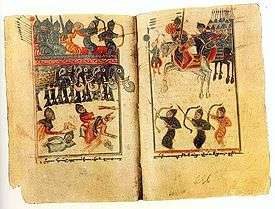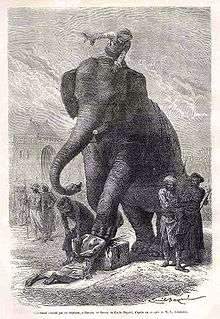Persian war elephants

Persians used war elephants at the Battle of Gaugamela in 331 BC. The battle raged between king Alexander the Great of Macedon and king Darius III of Persia. The Persians had 15 Indian-trained war elephants, which were placed at the centre of the Persian line, and they made such an impression on the Macedonian troops that Alexander felt the need to sacrifice to the God of Fear the night before the battle. Despite this the Persians lost the battle, relinquishing the Achaemenid Persian empire to Alexander. Elephants were later used by the Sassanids under a special chief, known as the Zend−hapet, or "Commander of the Indians," as they were from India.
History
Under the Achaemenids
The Persians are known to have used fifteen war elephants at Gaugamela, but some people claim that they had been used previously in the Greek campaign of King Xerxes I of Persia, and even further back at the time of Darius the Great at the Indus, the Danube and against the Scythians in 512 BC. Neither Xenophon nor Herodotus mention war elephants in their accounts of these earlier campaigns.
Under the Sassanids
.png)
Armenian wars
The most famous was the Battle of Avarayr (Armenian: Ավարայրի ճակատամարտ) in 451 AD, where Armenian rebels led by Vartan Mamikonian led an army of 66,000 men to gain independence from the Sassanids under Yazdegerd II, who opposed them with 300,000 men and war elephants.
Despite their victory over the rebels and the death of their leaders (including Vartan Mamikonian), Yazdegerd's forces gave the Armenians their religious freedom, largely due to the fierce and relentless spirit that they presented in the battle. While they won the battle, Persian forces had a disproportionate number of casualties and deaths compared to the Armenians.
Origin and training

The elephants were hired as mercenary troops with their riders. They came from Indian territories under Persian rule. Some historians say that some were from Iran. They were called the Syrian elephant but this may be incorrect.
Persian war elephants were trained by their rider, called a mahout, who would also ride the elephant into battle. The mahouts were of Indian origin, and so were the archers. Training elephants was a difficult and they would be hard to maintain because they ate so much food and water. On the march, huge paths needed to be cut for the elephants. Many were kept in the shah's menagerie the most famous of which was Khosrau II where he kept a "thousand white elephants."
Weapons
Persian elephants were from Indian origin and were probably armed with Indian styled weapons. The men(excluding the driver) sat in a large tower from which troops would fight. The elephant itself would normally be armed with thin plate armour (the Sassanids used chain mail as well as thin plate armour)and would bear a large crenelated wooden howdah on its back.[1] The troops would be armed with bow and arrows and javelin. The sworn enemy of the Sassanids, the Eastern Roman empire, were terrified by the huge beasts, making them very effective in battle. When they were used at the Battle of al-Qādisiyyah, they came to be known as "double edged weapons". King ( shah ) Yazdgerd III attempted to use war elephants to fight off Arab invaders, however his elephants got sand in their eyes and panicked. They turned around and ran amok, killing their own troops.
Crushing by elephant

(Persian: زير پى ِپيل افكندن; literally "casting beneath an elephant's feet")
Those people that were traitors to the army, enemies of the empire and criminals were crushed by the elephants this way and executed in the age of Sassanids they also used this method of execution for training for battle.
In popular culture
- Shatranj (Persian chess) - which Modern chess has gradually developed from it, same as Indian chess includes the war elephant with the name (fil),meaning elephant in Persian as the bishop.
See also
- War elephant
- Crushing by elephant
- Sassanid army
- History of elephants in Europe
- List of historical elephants
- Military animals
- Cavalry tactics
References
- ↑ Michael B. Charles, ‘The Rise of the Sassanian Elephant Corps: Elephants and the Later Roman Empire’, Iranica Antiqua 42 (2007) 301-346
- David Nicolle, Sassanian Armies : the Iranian empire early 3rd to mid-7th centuries AD (Montvert Publishing 1996). ISBN 1-874101-08-6
- Philip Rance, ‘Elephants in Warfare in Late Antiquity’, Acta Antiqua Academiae Scientiarum Hungaricae 43 (2003) 355-384
- Peter Wilcox, Rome's Enemies 3: Parthians and Sassanid Persians (Osprey Publishing 2001). ISBN 0-85045-688-6
Encyclopædia Iranica
External links
- http://www.iranian.com/main/2011/jul/ancient-world-war-0
- http://www.iranchamber.com/history/parthians/parthians.php
- http://www.artarena.force9.co.uk/sass2.htm